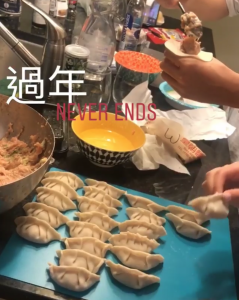Dumplings have always been a big food for my family and me. We eat dumplings throughout the year, but to me they represent more than just a basic Chinese dish. This dish consists of pork wrapped in a thin layer of dough. These can then be boiled, steamed, or pan fried. My personal favorite is steamed dumplings. This dish reminds me of family gatherings where we would all come together and make them. We would have them when my brothers came back from college or when my aunt would come back to town. This is also a dish that we eat at Chinese New Year, one of the biggest holidays for my family. This dish is very important in the Chinese culture because the dumplings are in the shape of gold ingots. They represent wealth and prosperity, so we eat them during the new year in hopes of a wealthy year ahead of us. This has been a Chinese tradition for many years. Every year, we would hide coins in a few dumplings. If you found one of the coins, you would have good luck in the coming year. This is one of my favorite new year’s traditions.
My grandparents took my mom to the United States when she was just eight years old. They then opened a Chinese restaurant and taught my mom and my aunts how to cook. Many years later, they taught me the same skills they had taught my mom. When I was younger, my grandfather taught me how to make the dumpling skin to prepare for the new year. We stayed in the kitchen all day to make them together. Letting the dough rest was the hardest part for me because I was so excited to start making the dumpling skins. When the dough was finally rested, we would roll out the dough together to make the wrappers. I always tried to roll them quickly to be like him, but he always reminded me to take it slow and practice so one day I could be as fast as him. My entire family would then help to wrap the dumplings while my mom was in charge of cooking them. My grandfather would hide coins in the dumplings while we were not looking so we didn’t know which dumplings would have them. We would carefully wrap each dumpling and place them on a cookie sheet. My brother enjoyed making dumplings that were shaped in different ways so he would know which ones he made after they were cooked. Two hours would go by and we would make a few hundred dumplings. It was amazing to see how many we could make in one sitting! My mom would pan fry half of them and steam the other half. Once they were cooked, we would all sit together at the dining table to eat our dumplings. We would talk about what we hoped for in this coming year and then we would light fire crackers in the back yard. These family traditions have always made Chinese New Year my favorite holiday.
Dumplings have been around for thousands of years. Each culture has their own type of dumpling, whether it is filled with meat or not. Dumplings were originally used to cure illness. One particularly cold winter, many Chinese citizens got sick and got frostbite from the cold. Zhang Zhongjing created these Chinese dumplings to fight of the sickness by feeding them something warm. People then made different kinds of dumplings based off of Zhang Zhongjing’s original recipe. Dumplings later became a Chinese new year tradition. People would make dumplings on New Year’s eve and eat them between 11:00 pm New Year’s eve and 1:00 am New Year’s day. This was a time of transition between the old year and the new year. These dumplings were a symbol of wealth and good fortune for the new year.


Ingredients
- 3 lbs green leafy vegetable (like shepherd’s purse, baby bok choy, napa cabbage, or Chinese chives)
- 1 ½ pounds ground pork (or ground chicken or beef, as long as they aren’t too lean)
- ⅔ cup shaoxing wine
- ½ cup oil
- 3 tablespoons sesame oil
- 1 tablespoon salt
- 3 tablespoons soy sauce
- ¼ teaspoon white pepper
- ⅔ cup water, plus more for assembly
- 3-4 packages dumpling wrappers
Instructions
- Wash your vegetables thoroughly and blanch them in a pot of boiling water. Transfer them to an ice bath to cool. Ring out all the water from the vegetables and chop very finely.
- In a large bowl, stir together the vegetable, meat, wine, oil, sesame oil, salt, soy sauce, white pepper, and ⅔ cup water. Mix for 6-8 minutes, until very well-combined.
- To wrap the dumplings, dampen the edges of each circle with some water. Put a little less than a tablespoon of filling in the middle. Fold the circle in half and pinch the wrapper together at the top. Then make two folds on each side, until the dumpling looks like a fan. Make sure it’s completely sealed. Repeat until all the filling is gone, placing the dumplings on a baking sheet lined with parchment. Make sure the dumplings aren’t sticking together.
- If you’d like to freeze them, wrap the baking sheets tightly with plastic wrap and put the pans in the freezer. Allow them to freeze overnight. You can then take the sheets out of the freezer, transfer the dumplings to Ziploc bags, and throw them back in the freezer for use later.
- To cook the dumplings, boil them or pan-fry them. To boil, simple bring a large pot of water to a boil, drop the dumplings in, and cook until they float to the top and the skins are cooked through, but still slightly al dente.
- To pan-fry, heat 2 tablespoons oil in a non-stick pan over medium high heat. Place the dumplings in the pan and allow to fry for 2 minutes. Pour a thin layer of water into the pan, cover, and reduce heat to medium-low. Allow dumplings to steam until the water has evaporated. Remove the cover, increase heat to medium-high and allow to fry for a few more minutes, until the bottoms of the dumplings are golden brown and crisp.
- Serve with soy sauce, Chinese black vinegar, chili sauce, or other dipping sauce of your choice!

Adrienne, your introduction paragraph is very strong as you combined history and cultural meaning of dumplings with your own experience of the dish. I’m glad you’ve accumulated such wonderful memories making dumplings over the years. I can understand why you enjoy Chinese New Year the most–the holiday you get to taste the best food and to spend with the most important people in the world. In comparison, I find your research paragraph lacking in that it presents only facts–without any connections to how you experience (and respond to) the history and tradition of dumpling eating. I would also encourage you to explore further the personal significance of the dumplings, specifically, to what extent do you see dumplings define you as a person (or change your self-perception over the years). Lastly, thanks for the lovely family photo (and beautiful dumplings)!